Greening of buildings has been used in construction for centuries and is therefore not a phenomenon of modern times. Indications of building greening can be found everywhere in the world. Starting with the grass-covered peat houses in Iceland and ending with the Japanese blue vine covering aal kind of buildings. But the oldest and probably best-known example is the Hanging Gardens of Semiramis, one of the Seven Wonders of the Ancient World. (Fig. 1)
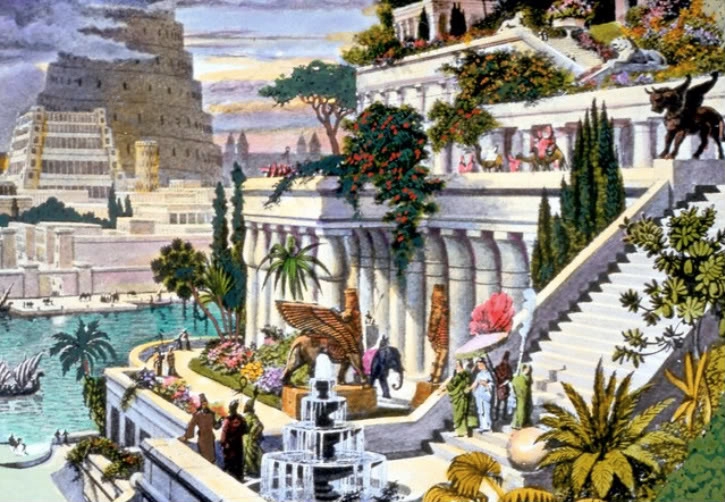
According to myths, the architectural marvel was created by King Nebuchadnezzar in Babylon in 600 BC, as a gift for his wife who missed the green mountains of her homeland (1). In 2013, this story was refuted with strong evidence by a researcher from Oxford University, who believes that the Hanging Gardens were not created in Babylon, but in Nineveh by King Sanherib (2). For context of this article, the place of origin of the Hanging Gardens is basically irrelevant, but what is of interest is that the planting took place not only on level ground, but also at height, for example on the roof or facade (3).
In addition to the stories of green myths, the Bible also describes a type of building greenery – the vine. The vine is the most frequently mentioned plant in the Bible (4). In the book of Genesis, among others, Noah is mentioned as the first vinedresser who cultivated vines after the stay on the ark (5).
References to wall plantings such as vines and ivy can be found again, especially at the time of the Middle Ages. Since that era, we can find vegetation on the facades of buildings. While ivy grew wild, vines, as well as fruit, were deliberately cultivated on building facades. (Fig. 2) These could often be found on walls of monasteries, since the vines could develop much better due to the stored heat on house walls (6).
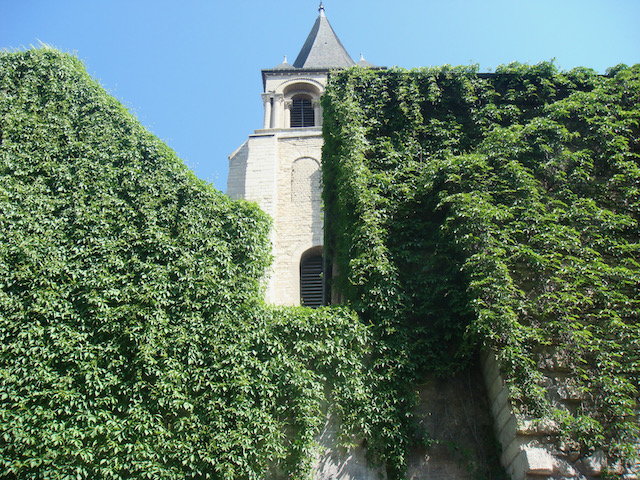
Abb.2 Greened parts of medieval buildings, Paris, 5. arr.
During the Baroque and Renaissance periods, there was a specific focus on greening buildings, as garden art was a central aspect (7). The walls of castles and other representative buildings were greened, such as the former Riesa monastery, which is greened with blue ivy (Fig. 3).
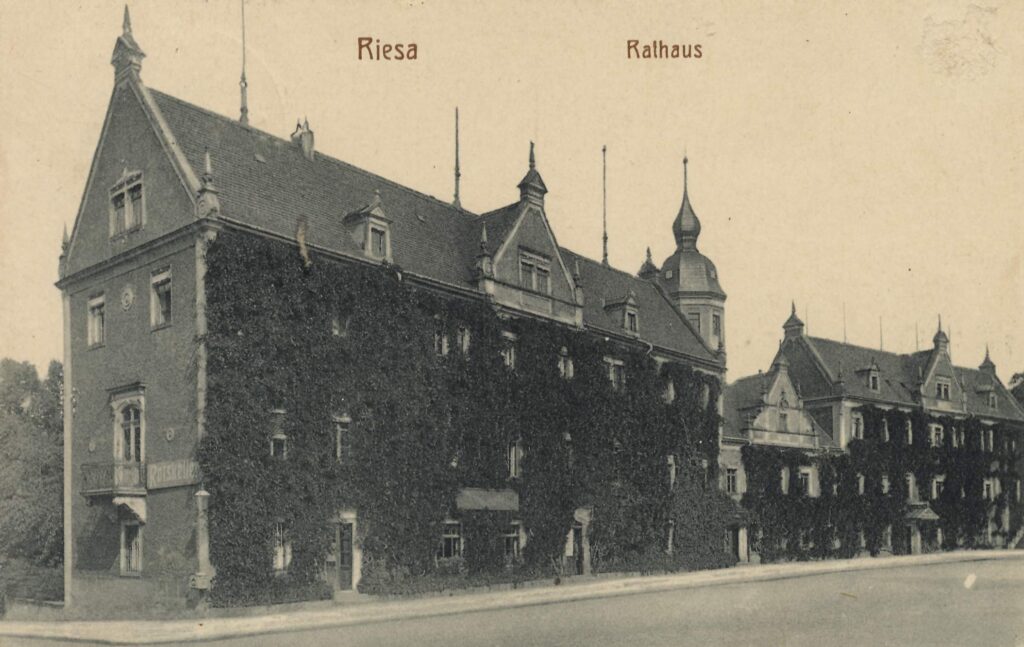
Above all, climbing plants and espaliered fruit were used in the plant-architecturally designed landscape gardens (8). In the era of Classicism, much of the Baroque was continued and climbing plants were used as an accent to structural elements. Classicist villas, country houses and castles by Karl Friedrich Schinkel can serve as examples here. These include the listed Waldstein Castle and the Roman Baths in Potsdam’s Sanssouci Park (Fig. 4).
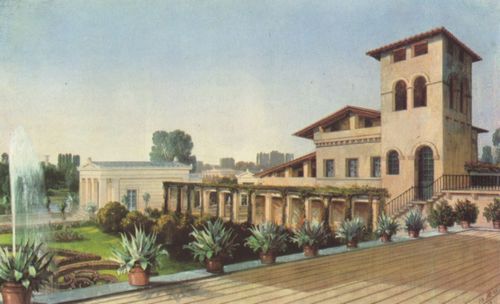
At the end of the 19th century, the garden city movement emerged as a countermovement to industrial-era urban development. The Englishman Ebenzer Howard developed the first ideas of a new urban model, which envisaged urban life in the countryside. First in England, and later in Germany, new settlement units were to be created that would combine living in the city and in the countryside. Important guiding principles of the garden city, in addition to non-segregation of social classes, were self-sufficiency. This was because the new cities were based on independence through self-sufficiency, which in turn could be ensured by the cultivated green spaces. The idea was: With the help of the construction of the new garden cities, the big cities were to be relieved and the influx of the rural population into the city was to be stopped. The goal: healthy living even within the cities. In the planning of the settlement units, particular emphasis was placed on the planting of green spaces, and the “climbing plant boom” reached its first peak within garden design (10). Marienbrunn, a district in Leipzig, took its cue from the modern garden city idea at the beginning of the 20th century and had climbing aids for wild vines added to house facades. (Fig. 5)

The idea of self-sufficiency continued into the 1920s. Favorites included fruit trellises, a special form of facade greening. A well-known landscape architect who promoted this type of building greenery on housing was Leberecht Migge. Indeed, he stated, “Every pergola, every espaliered fruit wall and house wall is an example of the possible blending of architecture and nature in the garden […]” (10), and “Speak no more of metropolitan misery and vices-flowers and greenery will cure them. Gardens are the response of great cities.”(11). He was thus implementing a tradition that was common in farmhouses in Bavaria and is still maintained to this day. (Fig. 6)
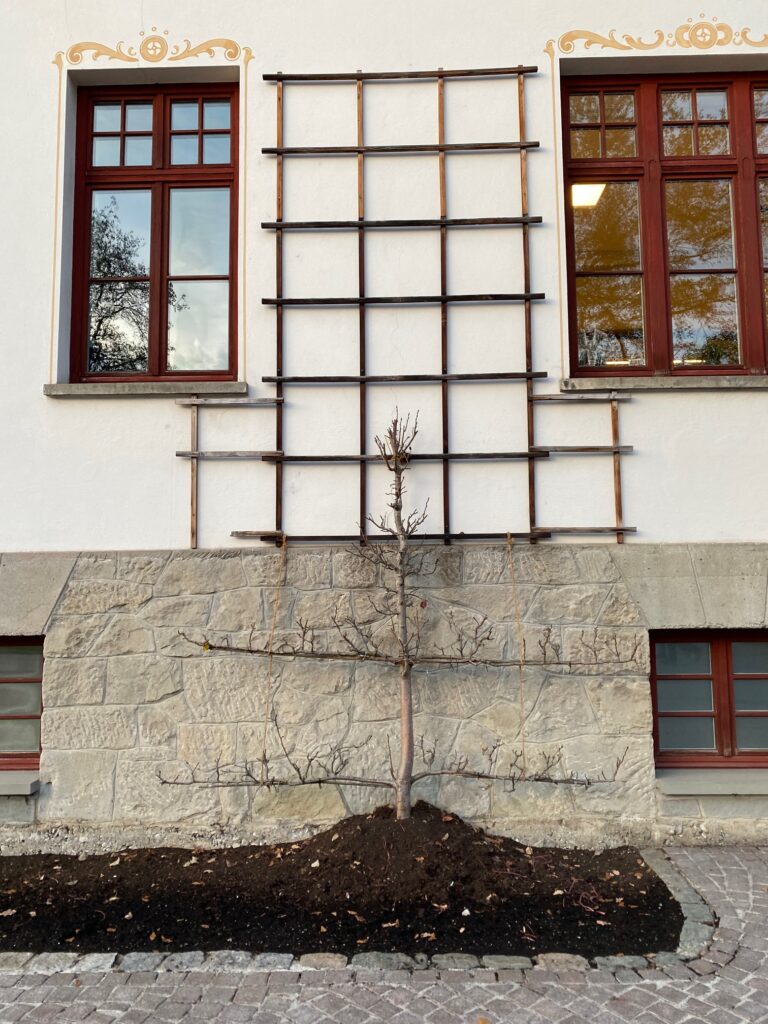
In the immediate post-war period, the focus was primarily on rebuilding the city. Here, societal interest was based primarily on economic growth and not on the greening of buildings. In early postwar publications, climbing plants played a role at best in garden design (11).
Facade greening did not come back to life until the 1980s, during the so-called “eco-movement” (12). This was mainly due to the fact that public interest in ecological issues increased significantly at that time, triggered by catastrophes such as the forest dieback or the reactor accident in Chernobyl. Thus, the pursuit of ecological concerns in the planning and redevelopment of large cities increased and became a topic of interest, albeit a very partial one.
Whereas in the decades before, the focus of building greening was on ornamentation and from practical points of view, greening in the context of the environmental movement was motivated by ecological considerations. Major empirical experiments were conducted for the first time, for example, investigating the impact of greening on the thermal and moisture balance of exterior walls (13). At the same time, incentive programs for facade greening were initiated in large cities and enabled by development plans (14). For the first time, green roofs and facades in subsidized housing can be found as classical forms of building greening (15). An interesting example is the Alterlaa residential park designed by Harry Glück, which used large plant troughs to create a living green area around residential buildings. (Fig.7 )

Abb.7 Alterlaa housing estate, Vienna. Architect Harry Glück.
Greening of buildings has recently received a further boost in the context of climate change. Starting in the 1970s, meteorological measurements became known that pointed to an accelerated rise in temperatures. Starting in the 1990s, biologists drew attention to the climate-reducing effects of greenery. At the beginning of the new millennium, Dutch/German urban planner Helga Fassbinder presented a concept that combined both findings with the facts of increasing world population and the need for dense urban building: Biotope City, the dense city as nature (16). This concept focuses on building greening as green roofs and green facades and links it to the fight against further biodiversity loss due to urban expansion. In Vienna, a model project based on this concept was built with the Biotope City Wienerberg, which attracted great attention in expert circles and was visited many times by delegations from various countries as one of the pilot projects of the International Building Exhibition Wine 2022.( Fig.8)
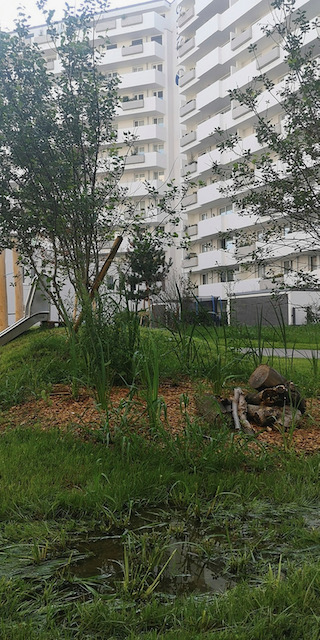

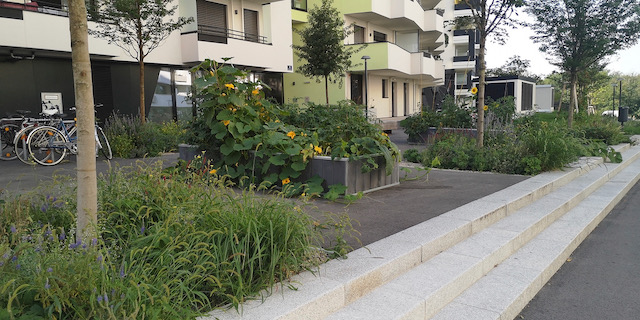
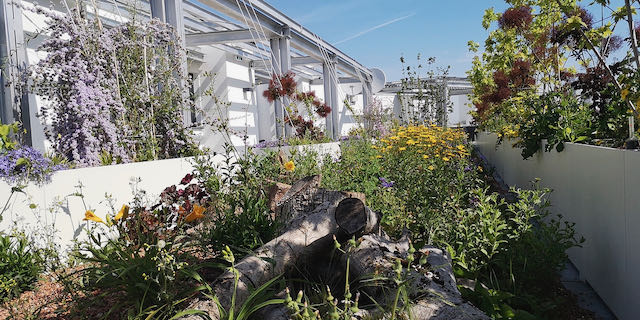
Abb.8 Biotope City Wienerberg, Vienna (Fotos Helga Fassbinder)
In the meantime, a number of large cities have recognized the benefits of intensive greening of their dense urban areas and, in some cases, have also included obligations to green buildings in their building regulations. In this context, it is not only the effect of greening as a temperature-reducing and at the same time cost-saving measure without any energy consumption that is decisive, but also the positive effects on health, well-being and social interaction.
Notes
(1) Vgl. ARD: Babylon – die hängenden Gärten der Semimaris (2014), in: [URL: https://www.youtube.com/watch?v=ho-tU4HPtTU0] (abgerufen am 15.11.2021).
(2) Vgl. o. A.: Hängende Gärten von Babylon existierten tatsächlich – in Ninive (06.05.2013), in: Süddeutsche Zeitung [URL: https://www.sueddeutsche.de/wissen/mythos-weltwunder-haengende-gaerten-von-babylon-existierten-tatsaech-lich-in-ninive-1.1666455] (abgerufen am 15.11.2021).
(3) Vgl. Opitz, Michael: Grünes Weltwunder (26.03.2020), in: Deutschlandfunk Kultur [URL: https://www.deutschlandfunkkultur.de/stefan-schweizer-die-haengenden-gaerten-von-babylon-gruenes.1270.de.html?dram:article_id=473104] (abgerufen am 15.11.2021).
(4) Vgl. Deutsche Bibelgesellschaft: Stichwort: Weinstock, in: Die Bibel [URL:https://www.die-bibel.de/lightbox/basisbibel/sachwort/sachwort/anzeigen/details/weinstock/] (abgerufen am 15.11.2021).
(5) Vgl. Lutherbibel: Gottesbund mit Noah, in: 1.Mose 9,20-27.
(6) Vgl. Taraba, Sven: Romanik und Gotik („Mittelalter“, ca. 800 – 1500), in: Fassadengrün e. K. [URL: https://www.fassadengruen.de/mittelalter.html] (abgerufen am 05.12.2021).
(7) Vgl. Linke, Tony: Gebäudebegrünung als Lärmschutzmaßnahme im innerstädtischen Raum –
Welchen Beitrag können Dach- und Fassadenbegrünungen zum Lärmschutz leisten?, Hamburg 2017, S. 37.
(8) Vgl. Ebd., S. 37.
(9) Vgl. Climagrün GmbH: Living Buildings, Bozen 2016, S. 5.
(10) Migge, Leberecht: Die Gartenkultur des 20. Jahrhunderts, Jena 1913, S. 96.
(11) Vgl. Radtke, Ulrich: „Ich dachte, das Thema ist durch?“, in: LA Landschaftsarchitektur, Nr. 12, Hamburg 2000, S. 25.
(12) Vgl. Linke 2017, S. 39.
(13) Vgl. Kießl, K.; Rath, J.: Auswirkungen von Fassadenbegrünung auf den Wärme- und Feuchtehaushalt von Außen- wänden und Schadensrisiko. Bericht aus dem Fraunhofer Institut für Bauphysik. Stuttgart 1989.
(14) Vgl. Radtke 2000, S. 25.
(15) Vgl. Reinwald, Florian, Weichselbaumer,Roswitha und Ring, Zita: Gebäudebegrünung im geförderten Wohnungsbau, in: Quartier. Fachmagazin für urbanen Wohnungsbau, Merching 2020, S. 8.
(16) H. Fassbinder, Biotope City, die Gartenstadt de 21. Jahrhunderts https://biotope-city.net/biotope-city-die-gartenstadt-des-21-jahrhunderts-2/
